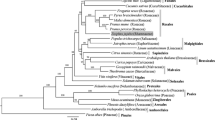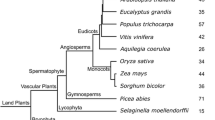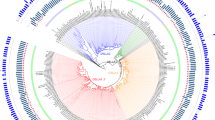Abstract
We present the first assessment of phylogenetic utility of a potential novel low-copy nuclear gene region in flowering plants. A fragment of the MORE AXILLARY GROWTH 4 gene (MAX4, also known as RAMOSUS1 and DECREASED APICAL DOMINANCE1), predicted to span two introns, was isolated from members of Digitalis/Isoplexis. Phylogenetic analyses, under both maximum parsimony and Bayesian inference, were performed and revealed evidence of putative MAX4-like paralogues. The MAX4-like trees were compared with those obtained for Digitalis/Isoplexis using ITS and trnL-F, revealing a high degree of incongruence between these different DNA regions. Network analyses indicate complex patterns of evolution between the MAX4 sequences, which cannot be adequately represented on bifurcating trees. The incidence of paralogy restricts the use of MAX4 in phylogenetic inference within the study group, although MAX4 could potentially be used in combination with other DNA regions for resolving species relationships in cases where paralogues can be clearly identified.





Similar content being viewed by others
References
Aagaard JE, Olmstead RG, Willis JH, Phillips PC (2005) Duplication of floral regulatory genes in the Lamiales. Amer J Bot 92(8):1284–1293
Albach DC, Martinez-Ortega M, Fischer MA, Chase MW (2004) Evolution of Veronicaceae: a phylogenetic perspective. Ann Missouri Bot Gard 91:275–302
Altschul SF, Madden TL, Schaffer AA, Zhang JH, Zhang Z, Miller W, Lipman DJ (1997) Gapped BLAST and PSI-BLAST: a new generation of protein database search programs. Nucl Acids Res 25:3389–3402
Álvarez I, Wendel JF (2003) Ribosomal ITS sequences and plant phylogenetic inference. Molec Phylogenet Evol 29:417–434
Angiosperm Phylogeny Group II (2003) An update of the angiosperm phylogeny group classification for the orders and families of flowering plants: APG II. Bot J Linn Soc 141:399–436
Archambault A, Bruneau A (2004) Phylogenetic utility of the LEAFY/FLORICAULA gene in the Caesalpinioideae (Leguminosae): gene duplication and a novel insertion. Syst Bot 29:609–626
Bailey CD, Price RA, Doyle JJ (2002) Systematics of the halimolobine Brassicaceae: evidence from three loci and morphology. Syst Bot 27:318–332
Bailey CD, Hughes CE, Harris SA (2004) Using RAPDs to identify DNA sequence loci for species level phylogeny reconstruction: an example from Leucaena (Fabaceae). Syst Bot 29:4–14
Barber JC, Francisco-Ortega J, Santos-Guerra A, Turner KG, Jansen RK (2002) Origin of Macaronesian Sideritis L. (Lamioideae: Lamiaceae) inferred from nuclear and chloroplast sequence datasets. Molec Phylogenet Evol 23:293–306
Benson DA, Karsch-Mizrachi I, Lipman DJ, Ostell J, Wheeler DJ (2007) GenBank. Nucleic Acids Res 35:D21–D25
Böhle UR, Hilger HH, Martin WF (1996) Island colonization and evolution of the insular woody habit in Echium L (Boraginaceae). Proc Natl Acad Sci USA 93:11740–11745
Bracho MA, Moya A, Barrio E (1998) Contribution of Taq polymerase-induced errors to the estimation of RNA virus diversity. J Gen Virol 79:2921–2928
Bradley RD, Hillis DM (1997) Recombinant DNA sequences generated by PCR amplification. Molec Biol Evol 14:592–593
Bräuchler C, Meimberg H, Heubl G (2004) Molecular phylogeny of the genera Digitalis L. and Isoplexis (Lindley) Loudon (Veronicaceae) based on ITS- and trnL-F sequences. Pl Syst Evol 248:111–128
Brysting AK, Oxelman B, Huber KT, Moulton V, Brochmann C (2007) Untangling complex histories of genome mergings in high polyploids. Syst Biol 56:467–476
Carlquist S (1974) Island biology. Columbia University Press, New York
Carvalho JA (1999) Systematic studies of the genera Digitalis L. and Isoplexis (Lindl.) Loud. (Scrophulariaceae: Digitaleae) and conservation of Isoplexis species. Ph. D. thesis, University of Reading, United Kingdom
Carvalho JA, Culham A (1998) Conservation status and preliminar results on the phylogenetics of Isoplexis an endemic Macaronesian genus. Bol Mus Municipal Funchal 5:109–127
Charlesworth D, Charlesworth B, McVean GAT (2001) Genome sequences and evolutionary biology, a two-way interaction. Trends Ecol Evol 16:235–242
Cline J, Braman JC, Hogrefe HH (1996) PCR fidelity of Pfu DNA polymerase and other thermostable DNA polymerases. Nucl Acids Res 24:3546–3551
Cox CJ, Goffinet B, Shaw AJ, Boles SB (2004) Phylogenetic relationships among the mosses based on heterogeneous Bayesian analysis of multiple genes from multiple genomic compartments. Syst Bot 29:234–250
Cronn RC, Small RL, Haselkorn T, Wendel JF (2002a) Rapid diversification of the cotton genus (Gossypium: Malvaceae) revealed by analysis of sixteen nuclear and chloroplast genes. Amer J Bot 89:707–725
Cronn RC, Cedroni M, Haselkorn T, Grover C, Wendel JF (2002b) PCR-mediated recombination in amplification products derived from polyploid cotton. Theor Appl Genet 104:482–489
DoE Joint Genome Institute and Poplar Genome Consortium (2004) Populus trichocarpa genome v1.0. http://genome.jgi-psf.org/Poptr1/Poptr1.home.html. Last accessed 28th Nov 2007
Doyle JJ (1992) Gene trees and species trees—molecular systematics as one-character taxonomy. Syst Bot 17:144–163
Doyle JJ, Doyle JL (1987) A rapid DNA isolation procedure for small quantities of fresh leaf tissue. Phytochem Bull Bot Soc Am 19:11–15
Erixon P, Svennblad B, Britton T, Oxelman B (2003) Reliability of Bayesian posterior probabilities and bootstrap frequencies in phylogenetics. Syst Biol 52:665–673
Felsenstein J (1985) Confidence limits on phylogenies: an approach using the bootstrap. Evolution 39:783–791
Francisco-Ortega J, Santos-Guerra A, Hines A, Jansen RK (1997) Molecular evidence for a Mediterranean origin of the Macaronesian endemic genus Argyranthemum (Asteraceae). Amer J Bot 84:1595–1613
Francisco-Ortega J, Fuertes-Aguilar J, Kim SC, Santos-Guerra A, Crawford DJ, Jansen RK (2002) Phylogeny of the Macaronesian endemic Crambe section Dendrocrambe (Brassicaceae) based on internal transcribed spacer sequences of nuclear ribosomal DNA. Amer J Bot 89:1984–1990
Ganders FR, Berbee M, Pirseyedi M (2000) ITS base sequence phylogeny in Bidens (Asteraceae): evidence for the continental relatives of Hawaiian and Marquesan Bidens. Syst Bot 25:122–133
Harris SA (1995) Systematics and randomly amplified polymorphic DNA in the genus Leucaena (Leguminosae, Mimosoideae). Pl Syst Evol 197:195–208
Helfgott DM, Francisco-Ortega J, Santos-Guerra A, Jansen RK, Simpson BB (2000) Biogeography and breeding system evolution of the woody Bencomia alliance (Rosaceae) in Macaronesia based on ITS sequence data. Syst Bot 25:82–97
Hirt RP, Logsdon JM, Healy B, Dorey MW, Doolittle WF, Embley TM (1999) Microsporidia are related to Fungi: evidence from the largest subunit of RNA polymerase II and other proteins. Proc Natl Acad Sci USA 96:580–585
Huelsenbeck JP, Ronquist F (2001) MRBAYES: Bayesian inference of phylogenetic trees. Bioinformatics 17:754–755
Hughes CE, Eastwood RJ, Bailey CD (2006) From famine to feast? Selecting nuclear DNA sequence loci for plant species-level phylogeny reconstruction. Philos Trans Roy Soc London B Biol Sci 361:211–225
Huson DH (1998) SplitsTree: analysing and visualizing evolutionary data. Bioinformatics 14:68–73
Joly S, Bruneau A (2006) Incorporating allelic variation for reconstructing the evolutionary history of organisms from multiple genes: an example from Rosa in North America. Syst Biol 55:623–636
Kim SC, Crawford DJ, Francisco-Ortega J, Santos Guerra A (1996) A common origin for woody Sonchus and five related genera in the Macaronesian islands: molecular evidence for extensive radiation. Proc Natl Acad Sci USA 93:7743–7748
Koch M, Haubold B, Mitchell-Olds T (2001) Molecular systematics of the Brassicaceae: evidence from coding plastidic matK and nuclear Chs sequences. Amer J Bot 88:534–544
Lawton-Rauh A (2003) Evolutionary dynamics of duplicated genes in plants. Molec Phylogenet Evol 29:396–409
Lemmon AR, Moriarty EC (2004) The importance of proper model assumption in Bayesian phylogenetics. Syst Biol 53:265–277
Linder CR, Rieseberg LH (2004) Reconstructing patterns of reticulate evolution in plants. Amer J Bot 91:1700–1708
Martin AP, Burg TM (2002) Perils of parology: using HSP70 genes for inferring organismal phylogenies. Syst Biol 51:570–587
Martins TR, Barkman TJ (2005) Reconstruction of Solanaceae phylogeny using the nuclear gene SAMT. Syst Bot 30:435–447
Mason-Gamer RJ, Weil CF, Kellogg EA (1998) Granule-bound starch synthase: structure, function and phylogenetic utility. Molec Biol Evol 15:1658–1673
Mathews S, Sharrock RA (1996) The phytochrome gene family in grasses (Poaceae): a phylogeny and evidence that grasses have a subset of the loci found in dicot angiosperms. Molec Biol Evol 13:1141–1150
Morrison DA (2005) Networks in phylogenetic analysis: new tools for population biology. Int J Parasitol 35:567–582
Mort ME, Crawford DJ (2004) The continuing search: low-copy nuclear sequences for lower-level plant molecular phylogenetic studies. Taxon 53:257–261
Nylander JAA (2004) MrModelTest 2.0. program distributed by the author. Evolutionary Biology Centre, Uppsala University
Olmstead RG, DePamphilis CW, Wolfe AD, Young ND, Elisons WJ, Reeves PA (2001) Disintegration of the Scrophulariaceae. Amer J Bot 88:348–361
Pamilo P, Nei M (1988) Relationships between gene trees and species trees. Molec Biol Evol 5:568–583
Panero JL, Francisco-Ortega J, Jansen RK, Santos-Guerra A (1999) Molecular evidence for multiple origins of woodiness and a New World biogeographic connection of the Macaronesian Island endemic Pericallis (Asteraceae: Senecioneae). Proc Natl Acad Sci USA 96:13886–13891
Posada D, Crandall KA (2001) Intraspecific gene genealogies: trees grafting into networks. Trends Ecol Evol 16:37–45
Ree RH, Citerne HL, Lavin M, Cronk QCB (2004) Heterogeneous selection on LEGCYC paralogs in relation to flower morphology and the phylogeny of Lupinus (Leguminosae). Molec Biol Evol 21:321–331
Rokas A, Carroll SB (2005) More genes or more taxa? The relative contribution of gene number and taxon number to phylogenetic accuracy. Molec Biol Evol 22:1337–1344
Rokas A, Williams BL, King N, Carroll SB (2003) Genome-scale approaches to resolving incongruence in molecular phylogenies. Nature 425:798–804
Sang T (2002) Utility of low-copy nuclear gene sequences in plant phylogenetics. Crit Rev Biochem Molec Biol 37:121–147
Sang T, Donoghue MJ, Zhang DM (1997) Evolution of alcohol dehydrogenase genes in peonies (Paeonia): phylogenetic relationships of putative nonhybrid species. Molec Biol Evol 14:994–1007
Schlüter PM, Stuessy TF, Paulus HF (2005) Making the first step: practical considerations for the isolation of low-copy nuclear sequence markers. Taxon 54:766–770
Small RL, Cronn RC, Wendel JF (2004) Use of nuclear genes for phylogeny reconstruction in plants. Austral Syst Bot 17:145–170
Snowden KC, Simkin AJ, Janssen BJ, Templeton KR, Loucas HM, Simons JL, Karunairetnam S, Gleave AP, Clark DG, Klee HJ (2005) The Decreased apical dominance1/Petunia hybrida CAROTENOID CLEAVAGE DIOXYGENASE8 gene affects branch production and plays a role in leaf senescence, root growth and flower development. Pl Cell 17:746–759
Soltis DE, Soltis PS (2000) Contributions of plant molecular systematics to studies of molecular evolution. Pl Molec Biol 42:45–75
Sorefan K, Booker J, Haurogne K, Goussot M, Bainbridge K, Foo E, Chatfield S, Ward S, Beveridge C, Rameau C, Leyser O (2003) MAX4 and RMS1 are orthologous dioxygenase-like genes that regulate shoot branching in Arabidopsis and pea. Genes Dev 17:1469–1474
Strand AE, LeebensMack J, Milligan BG (1997) Nuclear DNA-based markers for plant evolutionary biology. Molec Ecol 6:113–118
Swofford DL (2002) PAUP*-Phylogenetic analysis using parsimony (*and other methods): version 4.0b10. Sinauer, Sunderland
Syring J, Willyard A, Cronn R, Liston A (2005) Evolutionary relationships among Pinus (Pinaceae) subsections inferred from multiple low-copy nuclear loci. Amer J Bot 92:2086–2100
Tank DC, Sang T (2001) Phylogenetic utility of the glycerol-3-phosphate acyltransferase gene: evolution and implications in Paeonia (Paeoniaceae). Molec Phylogenet Evol 19:421–429
Tank DC, Beardsley PM, Kelchner SA, Olmstead RG (2006) Review of the systematics of Scrophulariaceae s.l. and their current disposition. Austral Syst Bot 19:289–307
Vriesendorp B, Bakker FT (2005) Reconstructing patterns of reticulate evolution in angiosperms: what can we do? Taxon 54:593–604
Wagner A, Blackstone N, Cartwright R, Dick M, Misof B, Snow P, Wagner GP, Bartels J, Murtha M, Pendleton J (1994) Surveys of gene families using polymerase chain reaction–PCR selection and PCR drift. Syst Biol 43:250–261
Whitlock BA, Baum DA (1999) Phylogenetic relationships of Theobroma and Herrania (Sterculiaceae) based on sequences of the nuclear gene Vicilin. Syst Bot 24:128–138
Whittall JB, Medina-Marino A, Zimmer EA, Hodges SA (2006) Generating single-copy nuclear gene data for a recent adaptive radiation. Molec Phylogenet Evol 39:124–134
Winkworth RC, Bryant D, Lockhart PJ, Havell D, Moulton V (2005) Biogeographic interpretation of splits graphs: least squares optimization of branch lengths. Syst Biol 54:56–65
Author information
Authors and Affiliations
Corresponding author
Appendix
Appendix
Table 6
Rights and permissions
About this article
Cite this article
Kelly, L.J., Culham, A. Phylogenetic utility of MORE AXILLARY GROWTH4 (MAX4)-like genes: a case study in Digitalis/Isoplexis (Plantaginaceae). Plant Syst Evol 273, 133–149 (2008). https://doi.org/10.1007/s00606-008-0008-0
Received:
Accepted:
Published:
Issue Date:
DOI: https://doi.org/10.1007/s00606-008-0008-0




